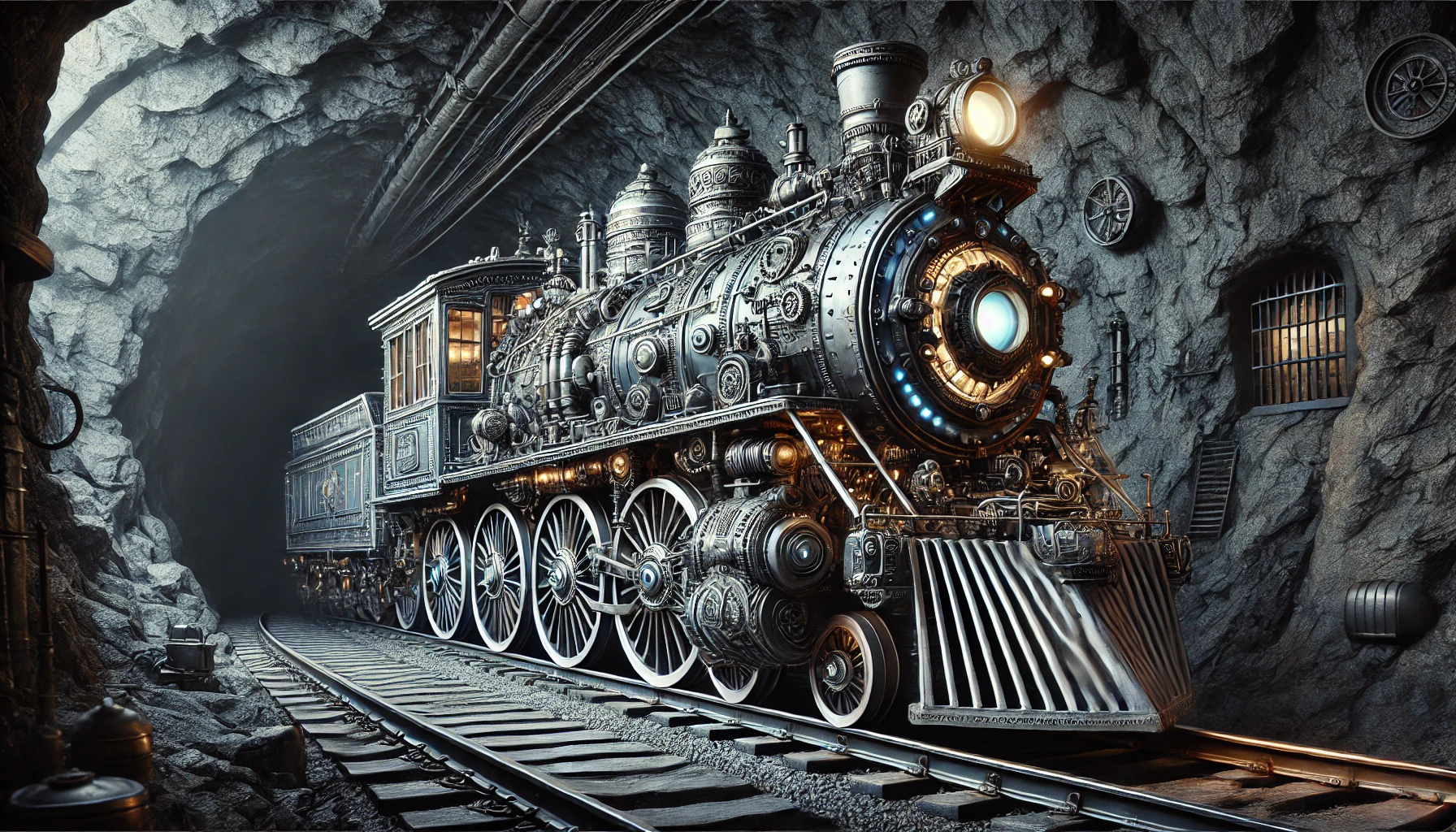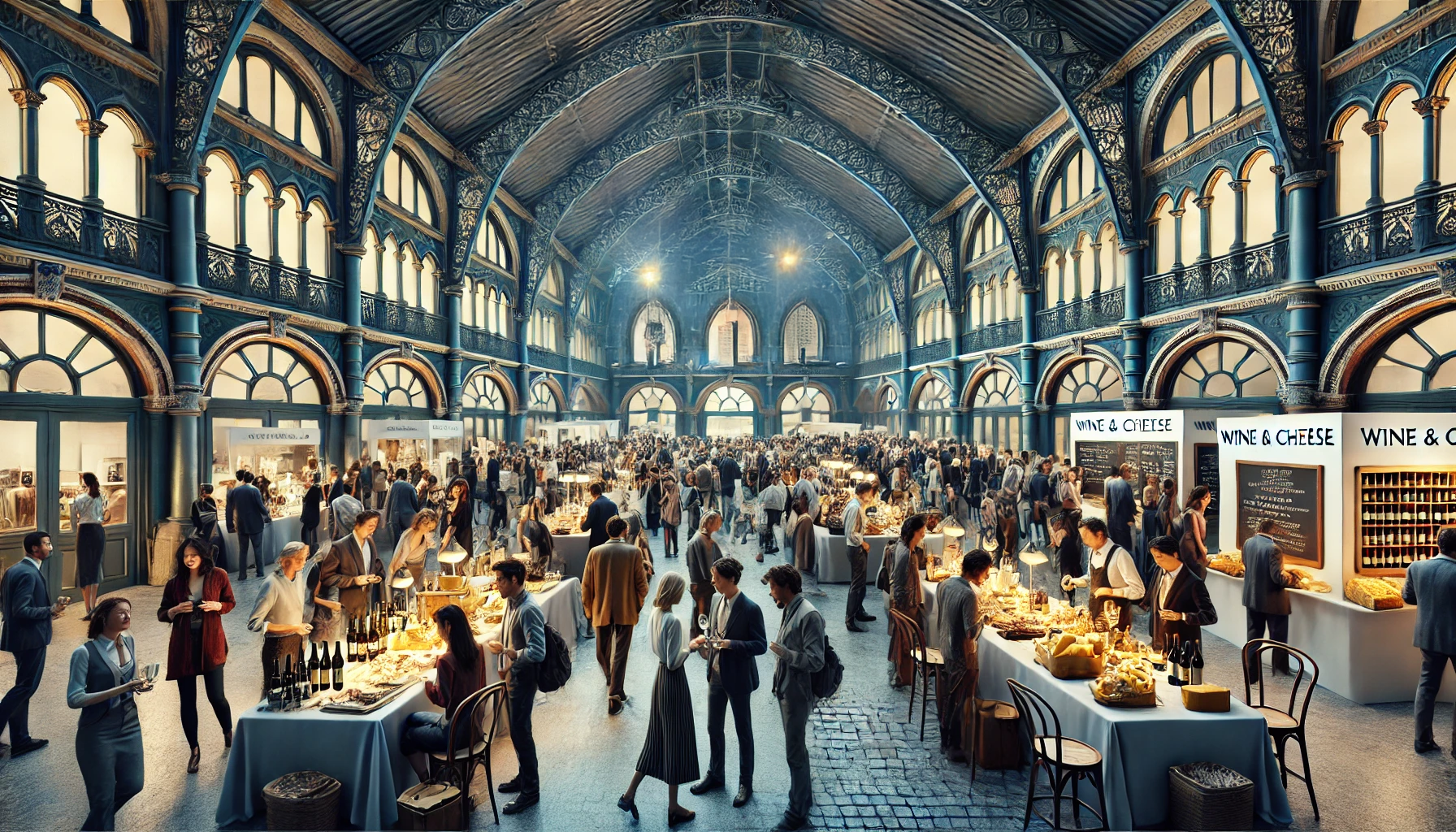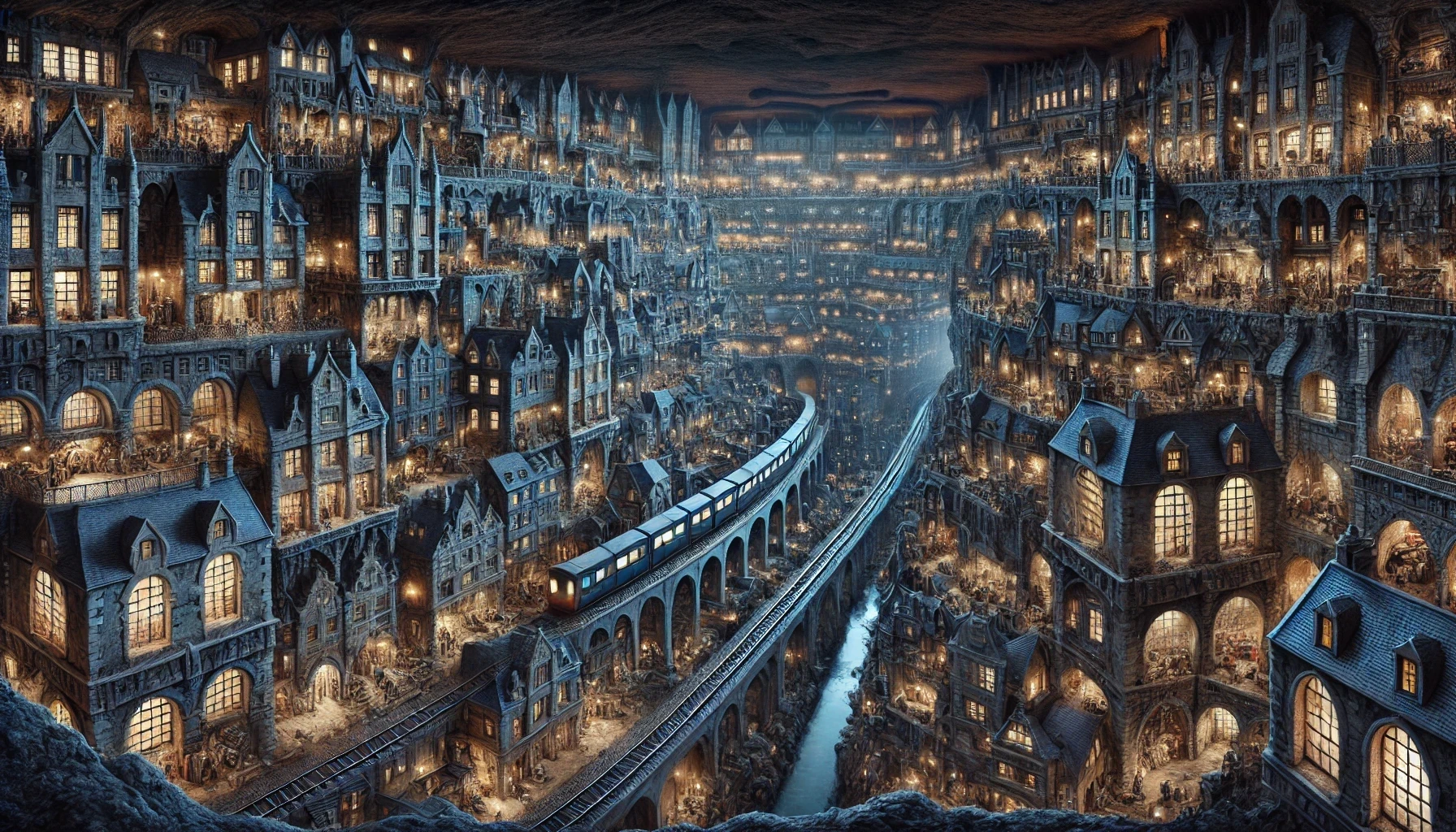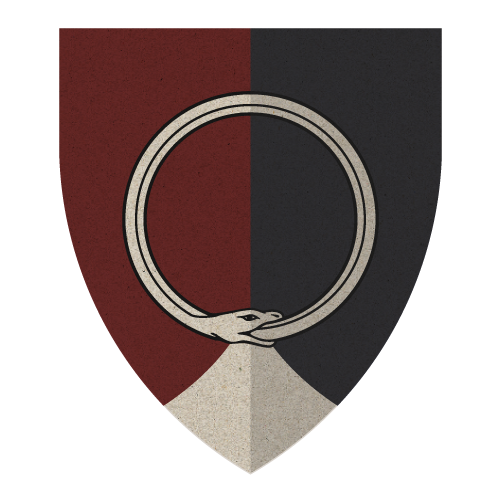Steffen
The underground capital of The Stiriphese
Introduction
Steffen (IPA: /ˈstɛffɛn/), also known as Stefan(IPA: /ˈstɛfæn/) in Anana, is a prominent subterranean city beneath Mount Steffen in The Stiriphese region of Favont. Originally developed as a sanctuary for the Nightwalker population, it has evolved into a bustling underground city marked by its compact, multi-layered architecture and vibrant communal life. Known for its artisanal cheese and wine production and its unique Winter Gardens, Steffen draws visitors nationwide. Its history includes pivotal moments such as The Reconstruction, and its population maintains cultural practices distinct from the rest of Favont. Steffen remains a critical centre for political, military, and cultural exchange, though it faces ongoing tensions related to language, religion, and external influence.
History
The Heart of Magic and Aeryn’s Curse10 BC - 1 AD
Aeryn DeSteffen arrived in Favont, or Marterra as it was known then, in 10 BC, exiled from her country of Peren, and reduced from a royal princess to an ambassador. In her first ten years, she met, and married Han Marisa, who was charged with guarding the Heart of Magic. In 1AD, her brother, and the King of Peren, Leric, sent her a letter saying that she would be accepted back if she found and exploited a weakness of the Marterrans. On the day of the invasion, Aeryn went to the caves beneath Mount Steffen , seeking The Heart of Magic, believing it to be the source of Marterran magic. She was unaware it was a portal to another plane. Meanwhile, on the battlefield, King Leric killed the Marterran king, Raan Ritan. His death was foretold to close the portal. Across the country, all the Marterrans began to dissapear, including her husband, Han Marisa, who had tried to stop her. Just before he dissapeared, he cursed Aeryn DeSteffen for her betrayal to eternal life in darkness and filled with guilt. After the battle, Leric found his sister. Realising she was no longer a pure Magi, and potentially a danger, he locked her away beneath Mount Steffen, guarded by an order of Astraen monks known as The Brothers. Aeryn would remain a prisoner for 300 years.
304 - 330
Prince Aegar, keen to end a siege with Asbeet, seeks out the myth of Aeryn, who he heard eats the flesh of her victims. He helps her escape imprisonment by killing her captors, The Brothers, and brought her to Asbeet to assassinate Jan Montpensier. Afterwards, Aeryn became the liaison between The Stiriphese and Favont and took the name Aeryn DeSteffen. This established Nightwalker political influence in the region. Over time, the caves of Steffen expanded into Aeryn’s palace and the city took shape.
432 - 573
- The Corbenites, fearing the power of Nightwalkers and Ananan magic, imposed strict restrictions. Nightwalkers and Ananans were banned from owning property outside The Stiriphese.
- Aeryn supported Jan Chamberlain’s revolution for democracy to lift these restrictions. Although Nightwalkers were forbidden from engaging, King Terys II later lifted the ban and used Nightwalkers to end the 14-year uprising.
591 - 596
A civil war erupted among the Nightwalkers when Arlene Dawes sought to farm Ananans for blood. Aeryn, with Ananan support, defeated Arlene, banishing her and her followers to Black Hollow. This internal conflict damaged the Nightwalkers' reputation, increasing distrust in Favont.
604
Magi allowed other classes to access aether-enabled technology. However, in The Stiriphese, the adoption of aether was slower due to the Ananans’ reliance on elemental magic. This marked the start of technological development in the region.
802
Aeryn officially founded the Strategic Defence Agency (SDA), headquartered in Steffen. Though Steffen had long been a centre for military strategy, the SDA’s formation formalised its role. Nightwalkers, humans, magi, and Ananans were employed, with Ananans limited to unofficial roles.
848 - 879
World War I drew many Nightwalkers from The Stiriphese to fight, with a significant number not returning. In 858, Ananans were permitted to leave The Stiriphese with Nightwalker sponsorship, but many chose to stay. During World War II, Ananans were blamed for bad luck, leading to distrust, and in 879, the SDA was relocated from Steffen to Esprite due to fears of Ananan influence.
890 - 941
The terrorist group Terva began attacks in 890, starting with a bombing in Asbeet. While The Stiriphese remained quiet, Terva activities increased outside the region. In 935, Queen Adelaide was assassinated in Steffen by Terva, triggering World War III. Both Nightwalkers and Ananans fought to defend Favont, but the war fizzled out due to a recession.
941 - 942
King Terys III ordered the binding of 20% of the human population and 100% of the Ananan population into service during the Reconstruction. Most Ananans were redistributed as slaves across Favont, while those who resisted were killed. Ibaleban, where many Ananans were slaughtered, was abandoned and is now a painful reminder of the past that free citizens of Steffen avoid discussing. While Aeryn claimed responsibility and declared The Stiriphese transformed, the region’s identity has been altered by the loss of the Ananans.
Geography
Steffen is an entirely subterranean city built into a vast network of volcanic caves beneath Mount Steffen. The city is characterised by an intricate layout, with narrow, winding streets and densely packed, tall buildings that are often stacked atop each other. Architectural elements include turrets, pointed arches, steep roofs, narrow windows, and stone façades, giving buildings a fortress-like appearance. Stairs twist around the buildings, leading to elevated walkways, which further connect different levels of the city.
- Major Caverns:
- Heart Cave (Hessia): The largest cavern, housing Steffen Palace, which was built around the area where The Heart of Magic was once located.
- Hidija and Hotene: Other significant caverns that feature mixed residential, commercial, and industrial zones.
- Infrastructure:
- Aetho-Magnetic Rail: The primary form of public transportation, linking various districts and providing rapid access across the city and beyond. Trains are modern, well-lit, and designed for comfort, with onboard services.
- Vertical Access: Steffen has an internal lift system for vertical movement within the mountain, in addition to external funicular railways for accessing the summit.
- Walkways and Stairs: Elevated walkways connect higher levels of the city, and steep staircases are common throughout, often interwoven with buildings. Some staircases even house small shops, maximising use of the limited space.
- Lighting: Large, aether-powered orbs hang from the cavern ceiling, bathing the city in a cool, consistent light. Street lights and lamps in buildings contribute to an artificial, perpetual evening atmosphere.
- Acoustics: Sound behaves unpredictably due to the enclosed caverns, making it difficult to locate the origin of noises. Some areas amplify sounds, while others deaden them, allowing for public gatherings without disturbing nearby residences.
- Ventilation: Large pipes ventilate fresh air from the surface, maintaining air quality. The air within the caverns has a faint earthy and metallic scent and remains at a consistent, cool temperature year-round.
Culture
Steffen’s culture is shaped by its unique environment, its Nightwalker majority, and a blend of local beliefs and external influences.
Social Customs and Daily Life
- Community: Residents live in close quarters, which fosters strong neighbourly relations and respect for communal living. Regulations on noise, cleanliness, and public conduct are strictly followed.
- Shops and Public Spaces: Steffen invests in public services such as shops, galleries, bars, and restaurants, which are designed to feel open despite the limited space. Markets are bustling, often with the smells of blood, wine, cheese, and leather, while art galleries offer quieter environments.
- Festivals and Gatherings: Celebrations, such as the First Grape, Corking Festival, and Cheese Fest, are held in marketplaces or parks, fostering community involvement. Parks are frequently used for art classes, yoga, and social gatherings, creating a sense of continuity in public life.
- Nightwalkers: Nightwalkers make up nearly 75% of the population and enjoy a sense of normalcy in Steffen. They work across a range of professions, including mid- to high-skilled jobs, leadership roles, and vocational careers. Nightwalkers are respected figures within Steffen but are often seen as eccentric or strange by outsiders.
Religion
- Belasa (The Ananan Faith): Belasa, meaning "belief" in Anana, is the predominant faith in Steffen, focusing on harmony with the world and respect for the soul within all things. Belasa has no formal structure, spiritual leader, or physical building, but shrines are scattered throughout the city for personal practice.
- Temple of Athelros: Dedicated to Athelros, the Angel of War, this temple is a place of worship for those who follow Cosmos, the larger faith of Favont. Historically, the temple coexisted peacefully with Belasa, but recent external influence has led to tension. The temple now promotes strict social hierarchy, the destruction of Belasa shrines, and the decline of the Anana language, dividing opinions among the Nightwalkers. Some Nightwalkers align with the temple’s new stance, while others have ceased visiting altogether.
Art, Architecture, and Aesthetics
- Architecture: Steffen’s architecture is both functional and whimsical, with interconnected buildings, turrets, narrow walkways, and compact spaces. Elevated pathways and staircases twist around buildings, leading to higher levels of the city. Statues are carved directly into the walls, with freestanding sculptures in parks and the Winter Gardens. Kinetic art is popular, with sculptures and installations that change over time or respond to environmental shifts.
- Galleries and Public Art: Art galleries and installations are widespread, drawing locals and tourists alike. Nightwalkers’ long lifespans allow for detailed, long-term artistic projects, and kinetic art pieces are designed to evolve and adapt over time.
- Public Facilities: Parks are used for festivals, yoga, art, and community events. Cafes, bars, and restaurants operate continuously to accommodate the city’s shift-work culture, reflecting the lack of day-night cycles underground.
Language and External Influence
- Language: Anana is the official language of The Stiriphese, but many businesses now use bilingual signage with Favontille due to outside pressure. Anana is gradually being replaced, though locals resist this change.
- Prejudices from Outside: Visitors bring differing attitudes, especially towards slaves and Pets, and often misunderstand Steffen’s traditions. Though the Nightwalkers value their isolation, increased tourism has introduced external expectations that challenge Steffen’s way of life.
Economy and Trade
Steffen’s economy is supported by a strong social hierarchy, tourism, artisanal production, and an established trade network.
Social Hierarchy and Labour Roles
- Hierarchy: Steffen’s social structure is more flexible than in the rest of Favont, with blurred distinctions between Nightwalkers, magis, and free humans. Nightwalkers dominate leadership and skilled roles, but magis and humans also hold important positions.
- Nightwalkers: Work across various roles, including leadership, mid- to high-skill positions, and vocational jobs.
- Magis: Typically hold roles in governance, education, and specialised technical fields.
- Free Humans: Often occupy skilled positions in trade, public service, or technical fields, though they have fewer opportunities for advancement than magis or Nightwalkers.
- Pets: Pets voluntarily serve Nightwalkers as companions and assistants, offering their blood in exchange for support. Though respected in Steffen, they are seen as "selling their soul" by outsiders.
- Slaves: Primarily human and Ananan, slaves perform manual labour in maintenance, agriculture, and domestic service. Steffen treats slaves with a level of respect uncommon in Favont, as open mistreatment is discouraged.
Key Industries
- Artisanal Goods: Steffen is known for its wine and cheese, matured in the cool, stable conditions of the caverns. Leather goods, jewellery, and luxury items are also produced by skilled artisans, contributing to the city’s reputation.
- Guilds: Numerous Guilds operate chapter houses in Steffen, including those for writing, art, music, cheese, wine, and hydroponics. These guilds provide structure and support to artisans, though their main headquarters are elsewhere.
- Tourism: Steffen’s unique subterranean environment, festivals, and cultural heritage draw visitors year-round, making tourism a major economic driver. Local markets, restaurants, and public events provide immersive experiences that appeal to outsiders.
Imports and Exports
- Exports: Steffen exports high-quality artisanal products such as wine, cheese, leather goods, and handcrafted luxury items.
- Imports: Like any modern city, Steffen imports essentials such as food, clothing, technology, and other necessities to support its urban population and sustain its infrastructure.
Military Presence
- Strategic Role: Steffen is a significant player in Favont’s military infrastructure, focusing on intelligence and planning. Although the main Strategic Defence Agency (SDA) headquarters are in Esprite, Steffen maintains a strong SDA presence through regional offices. Every Nightwalker has served in the military, and military service is a deeply integrated part of Steffen’s social fabric.
Current Problems
Steffen faces a range of modern challenges, from cultural erosion and social stratification to environmental pressures and shifts in its traditional military loyalties. These issues reflect the growing influence of external forces on Steffen's unique identity and community dynamics.
Cultural Erosion from Outside Influence- Language and Religious Tensions: Anana, the native language, and Belasa, the local faith, are slowly being overshadowed by Favontille and the Astraen faith due to increased external influence. Businesses and institutions now display bilingual signage, with Favontille becoming more prominent. The temple of Athelros, influenced by external authorities, promotes social hierarchy and has led to tension by encouraging the removal of Belasa shrines.
- Loss of Traditional Practices: As tourism and external expectations grow, traditional customs, including respect for the Ananan faith and cultural identity, are at risk. Some local Nightwalkers and humans resist these changes, but the influence of outside visitors and authorities is altering Steffen’s unique identity.
- Erosion of Flexible Social Structure: Steffen traditionally had a more fluid social hierarchy, with blurred lines between Nightwalkers, magis, and humans. However, as outside influence brings stricter hierarchies, distinctions are becoming more pronounced. The temple’s influence, along with social norms from the rest of Favont, is encouraging a more rigid structure, reducing opportunities for social mobility that Steffen once provided.
- Division Among Nightwalkers: Some Nightwalkers align with the temple's call for social hierarchy, while others resist, preferring the traditional egalitarian approach. This division has caused friction within the community.
- Treatment of Pets and Slaves: Visitors from other regions often bring prejudices and expectations that clash with Steffen’s norms. In Steffen, Pets are treated with respect and viewed as companions, but visitors may see them as "glorified slaves." This attitude creates tension and discomfort for Pets, as their role and worth are questioned.
- Stereotyping of Nightwalkers: Outsiders often misunderstand or fear Nightwalkers, viewing them as strange or even dangerous. This prejudice causes friction and can impact local businesses, community events, and the general sense of harmony in Steffen.
- Vulnerability to External Market Fluctuations: Steffen’s economy is heavily reliant on tourism and artisanal exports, such as wine, cheese, and luxury goods. This dependency makes Steffen vulnerable to economic downturns or shifts in consumer interest, which could affect its income and stability.
- Pressure on Local Identity: The focus on tourism has forced Steffen to cater to visitors, sometimes at the expense of its own cultural integrity. Local businesses are pressured to "modernise" or adapt to meet the demands of tourists, which can lead to a dilution of Steffen’s traditional values.
- Absence of the Ananan Community: The forced relocation and enslavement of Ananans during the Reconstruction left a significant void in Steffen’s social fabric. While some Ananans remain as Pets or slaves, the near-eradication of the Ananan population has left lingering emotional scars among those who once lived alongside them.
- Suppression of Mourning and Reflection: Outwardly, citizens must appear supportive of the Reconstruction to align with Favont’s narrative, which prevents open grieving or discussion about the events. This forced silence contributes to a pervasive sense of unresolved loss and a disconnection from Steffen’s cultural roots.
- Overcrowding and Limited Space: Steffen’s subterranean structure limits expansion, and every available space is used. The city’s compact, multi-layered design can lead to overcrowding, particularly as tourism and population pressures grow. This lack of space affects housing availability, public facilities, and accessibility.
- Complexity of Transportation and Accessibility: The Aetho-Magnetic Rail system is vital for quick transport, but its high demand strains the infrastructure. The steep stairways and winding walkways, while essential to Steffen’s layout, present accessibility issues for the elderly, disabled, or visitors unfamiliar with the city’s layout.
- Air Quality and Ventilation: While ventilation is carefully managed, Steffen’s enclosed environment makes air quality and circulation an ongoing challenge. As the population grows, the ventilation system requires more maintenance, which places additional pressure on resources.
- Decay of Older Structures: The centuries-old infrastructure, built into the cavern, requires regular upkeep. The high density of buildings and complex layering of structures make repairs and expansions difficult. Over time, older buildings and walkways may face structural integrity issues, adding further strain to Steffen’s maintenance demands.
- Divided Military Loyalties: The influence of the temple of Athelros and increasing pressure to align with Favont’s rigid hierarchy are creating divides among Nightwalkers and other residents with military backgrounds. While Steffen traditionally valued communal responsibility and loyalty to the city, outside influences now push a more centralised loyalty to Favont’s ruling powers.
- Potential for Civil Unrest: The steady erosion of Steffen’s traditional, more egalitarian values, coupled with increasing control from outside, may lead to dissatisfaction among residents who resist these changes. The potential for civil unrest grows as some community members feel alienated by these shifts.
44460
Steffen
"Steffen was everything to me once. The place I grew up, the people I knew. Now? It’s like a story I used to tell myself. My life’s elsewhere now, and I don’t look back."
"Steffen... I was just a kid. I remember it being loud—always busy, always people around. But I haven’t been back since. Feels like a lifetime ago. It doesn’t feel real anymore."
Aeryn DeSteffen
"Steffen was built long before the world understood what it could become. I shaped it—century by century. And if the world crumbles, Steffen will stand. It's my legacy."
"When I visit Steffen, it’s to honour my mother’s memory. The tributes are always proper, and everything is in place. It’s not about the city or the politics—it’s about showing respect, and I will always do that."
Janavier Rance
"Steffen? Creeps me out. Nightwalkers skulking in the dark, like they’re waiting for you to slip. And those caverns... Nah, I’ll stay far from that place, thanks."
Ari
"Steffen? That’s where the Nightwalkers live, right? I’ve heard they stalk the streets at night, looking for blood. And the Ananans? They say they dance under the moon, casting spells. I wouldn’t want to be anywhere near that place."
"I was born in Steffen, but it’s not my home. My mother’s still there, living as a pet, but I’d rather be anything else. A slave works with their hands, but a Pet... a Pet gives up more than that."
Pearl Lightly
"Steffen’s a place with deep roots—history, culture, all of it wrapped up together. It’s my job to know these things, and I do. Understanding where we’ve come from is just as important as where we’re headed."
Prince Veris
"I’ve read about Steffen—an entire city beneath the mountain. It’s not just about the size, though. There’s something fascinating about how it all functions, like it’s its own world. I’d like to see it for myself."

















